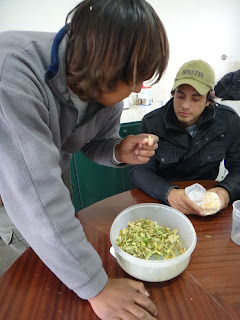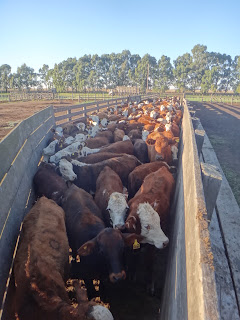All maize grown at La Candelaria is genetically modified. The corn seed used is a terminator seed, which means that the properties the purchased seeds contain are not passed on to the new supply of seeds grown in a harvest. As a result, unlike the soybean, wheat and sorghum which can be replanted year after year from the harvest yields, the maize seeds need to be purchased annually. (Even though new seeds aren't bought annually for some of the crops, royalties still need to be paid to the companies who developed the improved soybean, wheat and sorghum seeds every year based on the amount that is replanted for use the subsequent season.)
The maize seeds are bought from Monsanto, the world-leading producer of the herbicide glyphosate, popularly known by its brand name Roundup, and the second largest producer of genetically engineered seeds. 'Roundup Ready' maize is used at La Candelaria in order to facilitate the management of weeds in the fields. Corn is bought per seed and not by weight. You pay a premium for Roundup Ready bags of seed and for corn the premium is about $15 more per bag.
Silage
The silage production at La Candelaria is significant. Silage is the primary fodder fed to the animals in the feedlot. Given the number of animals in the feedlot (48,000 in 2011) and the rate at which they need to be fattened (generally over a 250 day period), the silage demands are very high. This year, 4000 hectares (30% of the cultivated land) are being harvested for silage.
Silage is a fermented, high-moisture fodder that is produced by chopping the entire corn plant when it is still in a green state - it has a high moisture content. The mulching of the corn is an impressive process. Currently Claas, a agricultural mechinery manufacturer from Germany, has a patent its silage harvesting technology which is advanced than its competitors. For example, the Claas Jaguar 900, in which I took a turn with the operator, with a head of 10 m width, can mulch 5 metric tons per minutes, which means it fills an 18-wheeler which generally have a capacity of 20 - 22 metric tons every 4-5 minutes.
The silage harvesters never stopped harvesting in the time I was at La Candelaria. There were generally two harvesters per field that were being serviced by 7-8 trucks per field. These trucks transported the silage to the silage mountain (currently claimed to be the largest in the world at 14 m high) non-stop all day, where six tractors were piling the silage and compressing it to create the proper pressure for an anarobic environment to ensure fermentation, before the mountain was covered in plastic and covered with tired to maintain the weight and coverage of the mountain.
Every field needs to be controlled. To do this, a sample of silage is taken from every field to be tested for its humidity content and the mulching effectiveness of the silage harvester. For the first test, we measure out 100 g of silage and put it into a microwave for 2 minutes. The silage is then weighed. Another 2 minutes. Another 2 minutes. Another 1.5 minutes...and so on until the silage is a palpable dryness to the sample. Be careful not to have the sample dry to the point of burning. The sample we measured decreased to 33 g and therefore had a moisture content of 67%. For the second test, we analyze how many whole grains remain in the silage. Whole grains are undesirable because the animals are not able to break down the whole grains to take full advantage of their energy content. There were no whole grains in our sample.
Determining the cost to the company of producing its own silage is a little bit complicated. Since the company also has the option of letting the crop go to seed which it could then sell commercially at a substantial profit, the theoretical production yield of each field harvested for silage needs to be determined by leaving a sample section. Essentially, a sample lot, generally of about 2 hectares, is left unharvested until it is ready to be harvested as corn. The weight per hectare of the corn is then determined for the field in question, and the total potential yield of the field is calculated. The theoretical market value of the field is then determined and charged to the company for the silage.
Corn
Corn is a high energy fodder that finishes the cattle well before being sent to market for butchering. During the growth, the first nitrogen application (NO3) is applied when the plant is between 0-20 cm and the second nitrogen applicaiton is applied when the plant is between 20-60 cm. Phosphorous is also applied as well as organic matter based on the percentages required by the soil. With the nitrogen application, like with all chemical applications to the fields, the quantities required can be precisely calculated. For example, the NO3 in the soil is converted into a total kg/hec and then the application is done to top up the quantity to an amount not to exceed 160 kg/hectare because no additional response is notable past this point. At 160 kg/hec, 10 metric tons of corn is generally harvested per hectare. The nitrogen is applied through urea applications.
For planting, the cycle is generally soil preparation, mulch burning, round up application, fertilizer appication, seeding. Corn is seeded at 5.3 plants per meter. The biggest problems growing corn are corn rust on the leaves, which affects the silage quality but not necessarily the seed quality, and pests such as aphids and schizaphis graminum. Actually it was remarkable to see that every cob (seemingly) had the top born into by a worm and the top of the ear destroyed. Apparently all corn suffers from this pest but the corn and silage is processed with the worms as well - they get sorted out through the machinery.
The loss rate that is tolerable for corn is 3% of a crop. If there is a greater loss, greater intervention need happen.
At the same time the efficiency of the harvesters need to be controlled. I must being by saying that controlling corn is certainly a much more intimidating process that the other crops - the reason is that you first need to mark out a section of the field on which you will be doing your test. While you are in the corn rows, unable to really see where you are or the other people you are working with because the plans are so high, you hear the harvester coming. To prep the test, we need to count how many seeds or ears of corn are already on the ground in the test area. Then befefore the machine arrives, you need to manually rip out the plants from an area so that you will be abe to throw four 1/4 square meter mats flat to various locations under the harvester. It is literally a race against approaching blades of death. Once the harvester passes, the number of seeds above and below the mats are tabulated to evaluate the loss of seed that are being taken in by the machine, separated from the cobs, but then discarded for whatever reason. Then, in the measure area, the number of cobs which are left whole, meaning they were not taken up by the machine, are counted too.
Once the corn is harvested it is brought to an area neighbouring the feedlot where it is processed by a mobile mill and stored in silo bags to be used to feed/finish the cattle in the feedlot throughout the year. The reason the corn is milled is because the cows are unable to properly digest dry corn on their own. By breaking up the seeds, the cows' stomach enzymes are able to better break down the carbohydrates and use the full potential of the fodder being fed to them.































